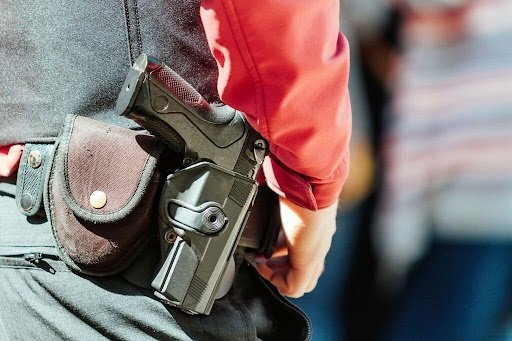The world of concealed carry has evolved significantly over the years, offering firearm enthusiasts a plethora of options when it comes to holsters. Two popular choices are bellyband holsters and traditional holsters, each with its unique set of advantages and disadvantages.
In this comprehensive guide, we will delve into the pros and cons of bellyband holsters and traditional holsters, helping you make an informed decision based on your specific needs and preferences.
Bellyband Holsters: A Closer Look
Pros
1. Versatility and Comfort
One of the standout features of bellyband holsters is their versatility. These holsters are typically elastic bands that can be worn around the torso, offering a wide range of adjustability.
The elastic nature allows for a comfortable fit for individuals of various body shapes and sizes. This adaptability makes bellyband holsters an excellent choice for those who value comfort during extended periods of wear.
2. Concealment in Various Outfits
Bellyband holsters stand out for their exceptional concealment capabilities, particularly accommodating diverse clothing styles. Whether you choose loose-fitting shirts, elegant dresses, or activewear, the bellyband holster adeptly conforms to your body’s contours.
This unique adaptability guarantees that your firearm stays discreetly concealed, eliminating concerns about printing or inadvertently revealing its presence.
This versatility makes bellyband holsters a practical choice for those seeking effective and inconspicuous concealed carry across a spectrum of wardrobe choices.
3. Ambidextrous Design
The ambidextrous design of many bellyband holsters provides a significant convenience for users who value flexibility in their carry options. This feature caters to both left- and right-handed individuals, allowing for seamless transitions between carrying sides.
For those naturally ambidextrous or those who prefer the ability to switch sides depending on the situation, this design ensures adaptability, making the bellyband holster a versatile and user-friendly choice for concealed carry enthusiasts.
4. Ability to Carry Multiple Items
In addition to accommodating a handgun, bellyband holsters often come with extra pockets or slots for carrying additional items such as spare magazines, a flashlight, or a small knife.
This added functionality can be beneficial for those who want an all-in-one solution for their everyday carry needs.

Cons
1. Limited Firearm Size and Weight
Bellyband holsters, despite their versatility, may pose limitations for those carrying larger or heavier firearms. The elastic nature of the holster might inadequately support the weight of such weapons, potentially causing discomfort and sagging.
This drawback underscores the importance of considering the specific firearm size and weight when choosing a holster to ensure optimal comfort and functionality during concealed carry.
2. Heat and Sweat Accumulation
In warmer weather, the use of a bellyband holster may lead to discomfort due to heat and sweat buildup around the torso. The lack of airflow exacerbates this issue, potentially causing irritation and making extended wear less pleasant.
Individuals considering bellyband holsters should be mindful of climate conditions, exploring alternative holsters if they prioritize comfort in hot seasons.
Traditional Holsters: A Comparative Analysis
Pros
1. Stability and Security
Traditional holsters, such as inside-the-waistband (IWB) or outside-the-waistband (OWB) options, provide a high level of stability and security for your firearm.
The rigid construction and secure attachment to the belt ensure that the weapon stays in place, minimizing movement and preventing accidental exposure.
2. Suitability for Larger Firearms
If you prefer carrying a larger or heavier firearm, a traditional holster is often a better choice. The sturdy materials and design of these holsters provide the necessary support, ensuring that the firearm remains securely holstered without causing discomfort or sagging.
3. Quick and Efficient Draw
Traditional holsters are renowned for their quick and efficient draw. The fixed position of the holster allows for a consistent and predictable draw stroke, making it an ideal choice for individuals who prioritize speed and reliability in self-defense situations.
4. Customization Options
Many traditional holsters offer a wide range of customization options. Users can choose different cant angles, retention levels, and materials, allowing for a personalized and tailored carrying experience.
This level of customization is particularly appealing to those who have specific preferences for their holster setup.
Cons
1. Limited Concealment in Certain Outfits
While traditional holsters excel in stability, they may pose challenges in terms of concealment, especially when wearing tight or light clothing.
The bulkiness of some traditional holsters can result in printing or visible outlines, potentially compromising the concealed aspect of carrying a firearm.
2. Less Comfortable for Extended Wear
Traditional holsters, particularly IWB options, may become less comfortable during extended periods of wear. The rigid materials and fixed positioning can lead to pressure points, causing discomfort, especially for individuals with a more active lifestyle.
Conclusion
Choosing between bellyband holsters and traditional holsters depends on personal preferences and needs. If comfort and versatility matter most, opt for a bellyband holster.
However, those prioritizing stability and customization, especially for larger firearms, may prefer a traditional holster.
Both have pros and cons, so explore options to find the perfect fit for your concealed carry goals, enhancing your overall experience and ensuring effective self-protection.
